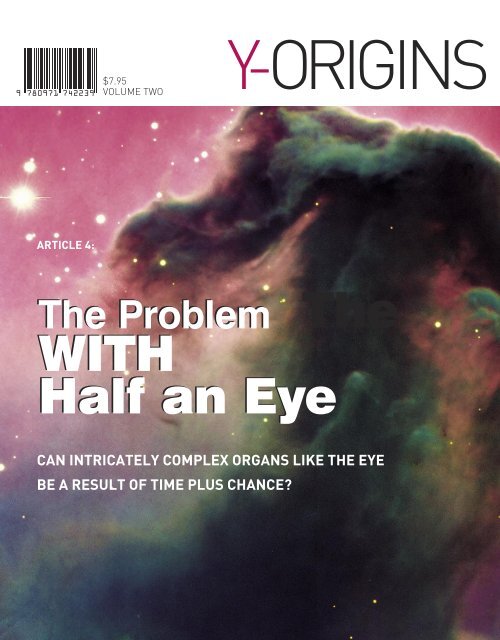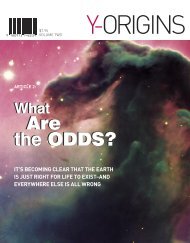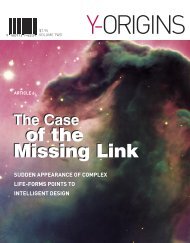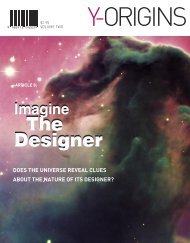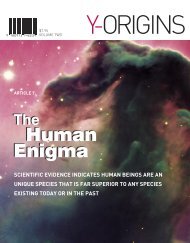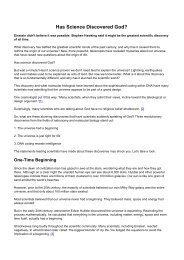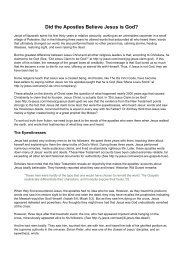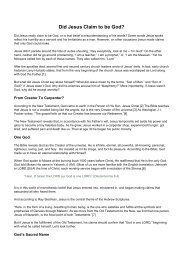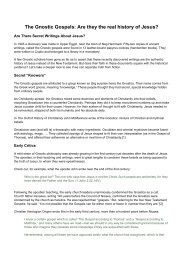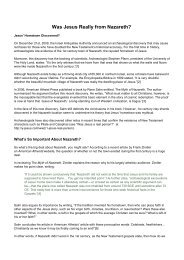half_an_eye4
You also want an ePaper? Increase the reach of your titles
YUMPU automatically turns print PDFs into web optimized ePapers that Google loves.
$7.95<br />
VOLUME TWO<br />
Y-ORIGINS<br />
ARTICLE 4:<br />
The Problem The<br />
WITH<br />
Half <strong>an</strong> Eye<br />
CAN INTRICATELY COMPLEX ORGANS LIKE THE EYE<br />
BE A RESULT OF TIME PLUS CHANCE?
INSTRUCTIONS<br />
To view the layout <strong>an</strong>d graphics, click on the Facing icon on the<br />
right side of your bottom tool bar in your Acrobat Reader © file. Try viewing at 75%.<br />
To read the article, click on the Single Page icon on the bottom right of your<br />
Acrobat Reader © file.<br />
To enlarge the print for easier viewing, click on the “+” by the<br />
magnifcation percentage in the middle of the tool bar at the top of the page.<br />
To move from one page to <strong>an</strong>other, use your side scroll bar or click on the<br />
left or right arrow in the bottom tool bar.<br />
CLICK HERE to see other articles from Y-Jesus Magazine at www.y-zine.com<br />
Chief Editor: Larry Chapm<strong>an</strong><br />
Project Coordinator: Helmut Teichert<br />
Editorial Director: Rick James<br />
Design: Hydragraphik ® Studio ( www.hydragraphik.com )<br />
Sun Mountain Productions<br />
Article Editors: Rick James, Eric St<strong>an</strong>ford<br />
Copy Editor: Eric St<strong>an</strong>ford<br />
Writers: Larry Chapm<strong>an</strong>, Rick James, Eric St<strong>an</strong>ford<br />
Y-ZINE<br />
PO Box 6017<br />
Great Falls, MT 59405<br />
Copyright 2006 by Bright Media Foundation <strong>an</strong>d B & L Publications. All rights reserved.<br />
ISBN 0-9717422-3-5<br />
2 • Y-JESUS
The Problem With Half <strong>an</strong> Eye<br />
Click on the e-article title for contents<br />
LOOKING AT THE EYE Page 6<br />
DARWIN’S BIG IDEA Page 6<br />
A BETTER MOUSE TRAP Page 7<br />
FINGERPRINTS OF A DISIGNER Page 8<br />
EXTREME PERFECTION AND COMPLECATION, INDEED Page 9<br />
ENDNOTES Page 10<br />
ACKNOWLEDGMENTS<br />
I am indebted to Dr. Bill Bright, who passed away before this project was finished. Dr. Bright enthusiastically endorsed <strong>an</strong>d<br />
contributed to the development of the material presented in this endeavor.<br />
Special th<strong>an</strong>ks are also due to Rick James <strong>an</strong>d Eric St<strong>an</strong>ford, who have both spent countless hours clarifying some of the concepts<br />
presented.<br />
Several others have contributed greatly to the writing of these articles, including Dr. Henry Br<strong>an</strong>dt, Dave Chapm<strong>an</strong>, Dr. Bert<br />
Harned, <strong>an</strong>d New Testament scholar, Dr. Ron Heine. The valuable input from Bri<strong>an</strong> Ricci, ‘Jamin Latvala, <strong>an</strong>d the Campus Crusade<br />
staff at the University of Washington were especially helpful <strong>an</strong>d constructive. Special th<strong>an</strong>ks also are due Helmut Teichert of<br />
Bright Media, who has been the overall director of the project. Finally I would like to th<strong>an</strong>k my wife, Mari<strong>an</strong>ne, for inspiring me to<br />
undertake this effort.<br />
Larry Chapm<strong>an</strong><br />
TABLE OF CONTENTS • 3
THE PROBLEM<br />
WITH<br />
HALF<br />
AN<br />
EYE<br />
CAN INTRICATELY COMPLEX ORGANS LIKE THE EYE<br />
BE THE RESULT OF TIME PLUS CHANCE?<br />
4• THE PROBLEM WITH HALF AN EYE • ARTICLE 4
Looking down at Greenl<strong>an</strong>d from 32,000<br />
feet on my trip from Rome to Seattle, I<br />
heard a str<strong>an</strong>ge noise in the aircraft that<br />
sent my blood pressure soaring into hyperspace.<br />
Suddenly I beg<strong>an</strong> to wonder what<br />
would happen if one tiny part on the enormous<br />
Boeing 747 failed. Engines, hydraulics,<br />
air pressurization—all were complex<br />
systems that worked only when several<br />
interdependent parts functioned properly.<br />
In vain I sought comfort in my airline<br />
pretzels, but comfort c<strong>an</strong> never be found in<br />
low-fat foods. I kept thinking of all those<br />
dedicated employees (excuse me: “members<br />
of the Boeing family”) shown on the commercials<br />
who apparently love nothing more in<br />
life th<strong>an</strong> a well-oiled 747 <strong>an</strong>d who perpetually<br />
ponder my safety. But the nagging thought<br />
still popped into my head: “Just one faulty or<br />
missing part <strong>an</strong>d I’d become part of the first<br />
bomb ever to be dropped on Greenl<strong>an</strong>d.”<br />
(those who believe nothing exists outside<br />
of the material world) assume there is some<br />
natural process that created such systems.<br />
The real issue here is whether or not a<br />
designer is behind such complexity. There<br />
are four possibilities:<br />
1. A designer created biological complexity<br />
supernaturally<br />
2. A designer created biological complexity<br />
through natural processes<br />
3. A designer combined natural<br />
processes <strong>an</strong>d supernatural me<strong>an</strong>s to<br />
create biological complexity<br />
4. A designer doesn’t exist. Complexity<br />
came about naturally.<br />
Materialists believe the latter. Scientists<br />
who advocate intelligent design generally<br />
agree that some superintelligence is behind<br />
it all, even though they leave the nature of<br />
a designer to theologi<strong>an</strong>s.<br />
THE EYE<br />
IS<br />
LIKE A<br />
TELEVISION<br />
CAMERA—BUT<br />
FAR MORE<br />
SOPHISTICATED<br />
In one sense, biological systems are like<br />
my Boeing 747: one missing or defective<br />
part <strong>an</strong>d they won’t work. Here lies one of<br />
the major un<strong>an</strong>swered problems of biology.<br />
How did highly complex, interdependent<br />
biological systems like the eye develop<br />
slowly over eons of time? They would never<br />
have worked until fully developed.<br />
Let’s step back for a minute <strong>an</strong>d think about<br />
all this.<br />
Airpl<strong>an</strong>es, automobiles, cell phones, computers,<br />
<strong>an</strong>d other complex machines, c<strong>an</strong><br />
always be traced back to a designer. However,<br />
with biological systems, materialists<br />
Here we must look at the evidence to see<br />
which of the possibilities makes the most<br />
sense. To determine the best option, we<br />
need to look closer at complex biological<br />
systems to determine whether they c<strong>an</strong> be<br />
explained by natural causes alone.<br />
THE PROBLEM WITH HALF AN EYE • ARTICLE 4• 5
LOOKING<br />
AT THE<br />
EYE<br />
The hum<strong>an</strong> eye is perhaps the best-known<br />
example of a complex system that couldn’t<br />
just pop up overnight. (“Say, Bill, what’s<br />
that thing growing on your face?” “I<br />
thought it was acne, but now that you mention<br />
it, I think I c<strong>an</strong> see out of it.”)<br />
With the eye we are not merely dealing<br />
with complexity, but with hundreds of<br />
separate parts that must work together in<br />
unison with incredible precision.<br />
Those who study the inner workings of the<br />
eye say it operates much like a television<br />
camera, but is far more sophisticated. In<br />
fact it is more sophisticated th<strong>an</strong> <strong>an</strong>y machine<br />
imaginable.<br />
DARWIN’S<br />
BIG IDEA<br />
Since the dawn of history, the eye <strong>an</strong>d other<br />
complex biological systems had baffled<br />
materialists. How could they exist without<br />
a designer? However, that ch<strong>an</strong>ged in 1859<br />
when biologist Charles Darwin published<br />
his revolutionary, The Origin of Species.<br />
The big idea in Darwin’s book was that<br />
life in all its complexity came about by a<br />
process he called natural selection. In other<br />
words, according to Darwin, no designer is<br />
needed. Materialists were elated.<br />
Darwin postulated that natural selection<br />
was totally responsible for the complexity<br />
of org<strong>an</strong>s like the eye, addressing the issue<br />
DARWIN ONCE STATED, “IF IT COULD BE DEMONSTRATED<br />
THAT ANY COMPLEX ORGAN EXISTED WHICH COULD NOT<br />
POSSIBLY HAVE BEEN FORMED BY NUMEROUS,<br />
SUCCESSIVE, SLIGHT MODIFICATIONS, MY THEORY<br />
WOULD ABSOLUTELY BREAK DOWN.”<br />
in a special section entitled, “Org<strong>an</strong>s of<br />
Extreme Perfection <strong>an</strong>d Complication.”<br />
In his special section Darwin brilli<strong>an</strong>tly<br />
argued that the eye might have developed<br />
in <strong>an</strong>y number of ways. His reasoning<br />
was that even a partially developed eye<br />
would offer a creature some evolutionary<br />
adv<strong>an</strong>tage.<br />
His expl<strong>an</strong>ation for the gradual development<br />
of such complex systems certainly<br />
had its critics, but by <strong>an</strong>d large his ideas<br />
were embraced because they helped to<br />
explain a great deal of the observable<br />
phenomena of our world.<br />
As the evolutionary movement grew, a<br />
great deal of evidence seemed to confirm<br />
Darwin’s theory, evidence similar to what<br />
you were taught in your high school textbooks.<br />
Adaptability, survival of the fittest,<br />
<strong>an</strong>d other Darwini<strong>an</strong> tenets are clearly<br />
demonstrable within a given species. Materialist<br />
Richard Dawkins remarks of Darwin’s<br />
accept<strong>an</strong>ce among most biologists, “Today<br />
the theory of evolution is about as much<br />
open to doubt as the theory that the earth<br />
goes round the sun….” 1<br />
As <strong>an</strong> atheist, Dawkins seems to applaud<br />
Darwin as the hero behind a purposeless<br />
world of ch<strong>an</strong>ce. He writes, “Darwin’s<br />
theory of evolution by natural selection<br />
is satisfying because it shows us a way<br />
in which simplicity could ch<strong>an</strong>ge into<br />
complexity, how unordered atoms could<br />
group themselves into ever more complex<br />
patterns until they ended up m<strong>an</strong>ufacturing<br />
people. Darwin provides a solution, the only<br />
feasible one so far suggested, to the deep<br />
problem of our existence.” 2<br />
Since Darwin’s theory was birthed in the<br />
mid-nineteenth century before the discovery<br />
of DNA <strong>an</strong>d the intricacies of how life<br />
works at the molecular level, there was no<br />
scientific evidence to refute his claims. By<br />
the mid-twentieth century, Darwinism had<br />
gained widespread accept<strong>an</strong>ce, but mounting<br />
evidence persuaded some scientists that<br />
his theory was incapable of accounting for<br />
life’s intricate complexity.<br />
This led to a series of meetings where<br />
scientists from various disciplines attempted<br />
to hammer out a coherent <strong>an</strong>d unified<br />
theory of evolution. The result was called<br />
the “evolutionary synthesis,” also known as<br />
Neo-Darwinism.<br />
But as Dr. Michael Behe, associate professor<br />
of biochemistry at Lehigh University,<br />
notes in his book Darwin’s Black Box, “One<br />
6• THE PROBLEM WITH HALF AN EYE • ARTICLE 4
<strong>an</strong>ch of science was not invited to the<br />
meetings [that produced the evolutionary<br />
synthesis], <strong>an</strong>d for good reason. It did not<br />
yet exist.” 3 Behe is referring to his own field<br />
of study, biochemistry.<br />
Behe’s field did not begin until later in the<br />
century, after the advent of the electron<br />
microscope. Yet biochemistry is perhaps<br />
the most critical of all the disciplines for<br />
this study, because it <strong>an</strong>alyzes life at the<br />
cellular level <strong>an</strong>d observes the molecular foundations<br />
of living org<strong>an</strong>isms.<br />
If Darwin’s general theory of evolution is a<br />
valid expl<strong>an</strong>ation of how life c<strong>an</strong> develop<br />
wholly apart from outside intelligence, then<br />
it must be demonstrated to be operating<br />
at the molecular level. But does Darwin’s<br />
theory hold up under such scrutiny?<br />
A BETTER<br />
MOUSETRAP<br />
Darwin once stated, “If it could be demonstrated<br />
that <strong>an</strong>y complex org<strong>an</strong> existed<br />
which could not possibly have been formed<br />
by numerous, successive, slight modifications,<br />
my theory would absolutely break<br />
down.” 4 Behe’s book, in essence, says,<br />
“OK, Charles, take a look at these!” And<br />
goes on to cite a h<strong>an</strong>dful of examples of<br />
what he calls irreducible complexity.<br />
By irreducible complexity, Behe me<strong>an</strong>s a<br />
single system of interrelated parts, where<br />
the absence or failure of <strong>an</strong>y part causes<br />
the entire system to non-perform or abort.<br />
In the airpl<strong>an</strong>e example, it could be a missing<br />
wing, rudder, or a defective integral<br />
part of the hydraulic system. In the eye,<br />
it could be a defective or missing cornea,<br />
retina, pupil, optic nerve, etc. All must work<br />
in concert for the eye to see.<br />
So how did each of these separate parts<br />
evolve together over eons of time? Could<br />
the eye have served <strong>an</strong>y purpose without<br />
being complete? We are not merely talking<br />
about a <strong>half</strong>-developed eye, but the eye<br />
at all its various stages of development<br />
throughout hundreds of millions of years<br />
(according to Darwin). Darwin himself stated<br />
that his theory (that all life is a product<br />
of natural processes alone) st<strong>an</strong>ds or falls<br />
on its ability to explain how <strong>an</strong> incomplete<br />
org<strong>an</strong> like the eye c<strong>an</strong> benefit a species.<br />
Behe uses a mousetrap as a nonliving example<br />
of irreducible complexity. Five basic<br />
parts of the trap must work together in<br />
order for it to catch mice: (1) a flat wooden<br />
platform; (2) a spring; (3) a sensitive catch<br />
that releases when pressure is applied;<br />
(4) a metal bar that connects to the catch<br />
<strong>an</strong>d holds the hammer back; <strong>an</strong>d (5) the<br />
hammer that serves as the instrument of<br />
death <strong>an</strong>d cruelty for our harmless mouse.<br />
A mousetrap needs each of these parts to<br />
kill mice. Each part works interdependently,<br />
<strong>an</strong>d so a partially constructed mousetrap<br />
serves no function <strong>an</strong>d is worthless.<br />
Behe’s book focuses on a h<strong>an</strong>dful of examples,<br />
though he states that <strong>an</strong>y biology<br />
book contains dozens of them. One of the<br />
examples he cites is the microscopic bacterial<br />
flagellum, which the bacterium uses as<br />
a miniature whiplike rotary motor to propel<br />
itself. The flagellum is a swimming device<br />
that works similar to a rotary propeller. It is<br />
described by Behe like this:<br />
Just picture <strong>an</strong> outboard motor on a<br />
boat <strong>an</strong>d you get a pretty good picture<br />
of how the flagellum functions, only the<br />
flagellum is far more incredible. The<br />
flagellum’s propeller is long <strong>an</strong>d whiplike,<br />
made out of a protein called flagellum.<br />
This is attached to a drive shaft by<br />
hook protein, which acts as a universal<br />
joint, allowing the propeller <strong>an</strong>d drive<br />
shaft to rotate freely. Several types of<br />
protein act as bushing material (like<br />
washer/donut) to allow the drive shaft<br />
to penetrate the bacterial wall (like the<br />
side of a boat) <strong>an</strong>d attach to a rotary<br />
motor. … Not only that but the propeller<br />
c<strong>an</strong> stop spinning within a quarter turn<br />
<strong>an</strong>d inst<strong>an</strong>tly start spinning the other<br />
direction at 10,000 rpms. 5<br />
“NOW THAT THE BLACK<br />
BOX OF VISION HAS<br />
BEEN OPENED, IT IS<br />
NO LONGER ENOUGH FOR<br />
AN EVOLUTIONARY EX-<br />
PLANATION…EACH OF THE<br />
ANATOMICAL STEPS AND<br />
STRUCTURES THAT DAR-<br />
WIN THOUGHT WERE SO<br />
SIMPLE ACTUALLY<br />
INVOLVED STAGGERINGLY<br />
COMPLICATED BIOCHEMI-<br />
CAL PROCESSES THAT<br />
CANNOT BE PAPERED<br />
OVER WITH RHETORIC.” 6<br />
-Michael Behe<br />
Professor of Biochemistry<br />
THE PROBLEM WITH HALF AN EYE • ARTICLE 4• 7
The flagellum’s molecular motor requires<br />
20 proteins, all working in synchrony, to<br />
function. Like the partially constructed<br />
mousetrap, the flagellum would be worthless<br />
<strong>an</strong>d perish unless all 20 proteins were<br />
fully developed.<br />
Dr. Robert Macnab of Yale University detailed<br />
the tiny molecular motor of the E. coli<br />
flagellum in a 50 page review, concluding<br />
that its development c<strong>an</strong>not be explained<br />
by Darwini<strong>an</strong> evolution. Labeling Darwin’s<br />
expl<strong>an</strong>ation <strong>an</strong> “oversimplification,”<br />
Macnab questions how a non-functional<br />
“preflagellum” could have evolved part by<br />
part with each being indispensable to its<br />
completed function. 7<br />
Another example Behe cites is what he calls<br />
“the intracellular tr<strong>an</strong>sport system” found<br />
within cells. The magnified cell in Darwin’s<br />
day looked something like <strong>an</strong> opaque p<strong>an</strong>cake<br />
jellyfish with a fuzzy-looking dark spot<br />
in the center called the nucleus. It all looked<br />
so simple. Only recently, under powerful<br />
magnification, have the mysteries of the cell<br />
begun to be unveiled.<br />
Molecular biologist Michael Denton uses<br />
a similar metaphor to describe the cell’s<br />
complexity:<br />
To grasp the reality of life as it has been<br />
revealed by molecular biology, we must<br />
magnify a cell a thous<strong>an</strong>d million times<br />
until it is twenty kilometers in diameter<br />
<strong>an</strong>d resembles a gi<strong>an</strong>t airship large<br />
enough to cover a great city like London<br />
or New York. What we would then see<br />
would be <strong>an</strong> object of unparalleled complexity<br />
<strong>an</strong>d adaptive design.<br />
On the surface of the cell we would<br />
see millions of openings, like the port<br />
holes of a vast space ship, opening <strong>an</strong>d<br />
closing to allow a continual stream<br />
of materials to flow in <strong>an</strong>d out. If we<br />
were to enter one of these openings<br />
we would find ourselves in a world of<br />
supreme technology <strong>an</strong>d bewildering<br />
complexity. 8<br />
But, again, it is not simply complexity;<br />
it is irreducible complexity. Going back<br />
to Behe’s illustration of the mousetrap,<br />
everything must be in place for the system<br />
to work. Missing just one component, the<br />
whole system is worthless. Behe remarks,<br />
The point of irreducible complexity<br />
is…that the trap we’re considering<br />
right now needs all of its parts to<br />
function. The challenge to Darwini<strong>an</strong><br />
evolution is to get to my trap by<br />
me<strong>an</strong>s of numerous, successive slight<br />
modifications. You c<strong>an</strong>’t do it. Besides,<br />
you’re using your intelligence as you<br />
try. Remember, the audacious claim<br />
of Darwini<strong>an</strong> evolution is that it c<strong>an</strong><br />
put together complex systems with no<br />
intelligence at all. 9<br />
FINGERPRINTS<br />
OF A DESIGNER?<br />
Several materialists have taken issue with<br />
Behe’s case for irreducible complexity, but<br />
none have adequately explained a process<br />
by which such complex org<strong>an</strong>s <strong>an</strong>d systems<br />
have evolved by mere ch<strong>an</strong>ce.<br />
Surprised at the sudden maelstrom caused<br />
by his book, Behe defends his position in<br />
The Boston Review. “The rotary nature of<br />
the flagellum has been recognized for about<br />
8• THE PROBLEM WITH HALF AN EYE • ARTICLE 4
25 years. During that time not a single<br />
paper has been published in the biochemical<br />
literature even attempting to show how<br />
such a machine might have developed by<br />
natural selection.” 10<br />
In The Flagellum Unspun, Ken Miller<br />
argues against irreducible complexity,<br />
labeling Behe <strong>an</strong>d other intelligent design<br />
advocates, “unimaginative.”<br />
EACH HUMAN EYE…<br />
• HAS OVER 100 MILLION RODS<br />
• HANDLES 1.5 MILLION SIMULTANEOUS MESSAGES<br />
• MOVES 100,000 TIMES EACH DAY<br />
• HAS AUTOMATIC FOCUSING<br />
• HAS SIX MILLION CONES<br />
• CAN DISTINGISH AMONG SEVEN MILLION COLORS 13<br />
Dr. William Dembski rebuts Miller’s objection<br />
by stating, “The problem is not that we<br />
in the intelligent design community…just<br />
c<strong>an</strong>’t imagine how those systems arose.…<br />
Darwin’s theory, without which nothing in<br />
biology is supposed to make sense, in fact<br />
offers no insight into how the flagellum<br />
arose.” 11<br />
James Shapiro, a biochemist at the University<br />
of Chicago, concurs, “There are<br />
no detailed Darwini<strong>an</strong> accounts for the<br />
evolution of <strong>an</strong>y fundamental biochemical<br />
or cellular system, only a variety of wishful<br />
speculations.” 12<br />
Darwin’s Black Box is a scientific book, not<br />
a theological one, but Behe has been joined<br />
by a growing number of scientists who<br />
claim they see the fingerprints of intelligent<br />
design within irreducibly complex biological<br />
systems. One of them,cosmologist All<strong>an</strong><br />
S<strong>an</strong>dage has remarked: “The world is too<br />
complicated in all its parts <strong>an</strong>d interconnections<br />
to be due to ch<strong>an</strong>ce alone. …<br />
The more one learns of biochemistry the<br />
more unbelievable it becomes unless there<br />
is some type of org<strong>an</strong>izing principle—<strong>an</strong><br />
architect for believers.” 14<br />
EXTREME<br />
PERFECTION AND<br />
COMPLICATION, INDEED<br />
materialistic evolution, complex structures<br />
like the hum<strong>an</strong> eye are not simply a hard<br />
pill to swallow but rather a chicken bone<br />
stuck in the throat. Intuitively, we struggle<br />
to imagine how such a structure could<br />
slowly develop over time <strong>an</strong>d what use a<br />
<strong>half</strong>-developed eye would serve.<br />
A careful reading of Darwin’s expl<strong>an</strong>ation in<br />
“Org<strong>an</strong>s of Extreme Perfection <strong>an</strong>d Complication”<br />
reveals that he never <strong>an</strong>swers the<br />
problem. In fact, regarding how the eye got<br />
started, Darwin stated, “How a nerve comes<br />
to be sensitive to light hardly concerns us<br />
more th<strong>an</strong> how life itself originated.” 15<br />
Did Darwin really believe the eye evolved<br />
bit by bit over time? Although his theory<br />
attempts to explain how it could have happened,<br />
m<strong>an</strong>y believe Darwin himself was<br />
unconvinced. Years after he had written his<br />
world-ch<strong>an</strong>ging theory Darwin admitted<br />
to a friend, “The eye to this day gives me a<br />
cold shudder.” 16 Hmm…<br />
We beg<strong>an</strong> this article by mentioning the<br />
objection of the hum<strong>an</strong> eye as it was raised<br />
<strong>an</strong>d addressed by Darwin. For most people<br />
coming to grips with the implications of<br />
THE PROBLEM WITH HALF AN EYE • ARTICLE 4• 9
ENDNOTES<br />
“THE MORE ONE LEARNS<br />
OF BIOCHEMISTRY THE<br />
MORE UNBELIEVABLE IT<br />
BECOMES UNLESS THERE<br />
IS SOME TYPE OF<br />
ORGANIZING PRINCIPLE—<br />
AN ARCHITECT FOR<br />
BELIEVERS.”<br />
All<strong>an</strong> S<strong>an</strong>dage,<br />
Cosmologist<br />
1. Richard Dawkins, The Selfish Gene (Oxford:<br />
Oxford University Press, 1989),1.<br />
2. Ibid.,12.<br />
3. Michael Behe, Darwin’s Black Box (New<br />
York: Free Press, 2003), 24.<br />
4. Charles Darwin, Origin of Species (New<br />
York: B<strong>an</strong>tam Books, 1999), 158.<br />
5. Behe, 22.<br />
6. Quoted in Lee Strobel, The Case for a<br />
Creator (Gr<strong>an</strong>d Rapids, MI: Zonderv<strong>an</strong>,<br />
2004), 199.<br />
7. Macnab, R. (1978), “Bacterial Mobility<br />
<strong>an</strong>d Chemotaxis: The Molecular Biology of<br />
a Behavioral System,” CRC Critical Reviews<br />
in Biochemistry, vol. 5, issue 4, Dec., 291-<br />
341.<br />
8. Michael Denton, Evolution: A Theory in<br />
Crisis (Chevy Chase, MD, Adler & Adler,<br />
1986), 328.<br />
9. Quoted in Lee Strobel, The Case for a<br />
Creator, 199.<br />
10. Michael Behe, “The Sterility of Darwinism,”<br />
Boston Review, February/March 1997.<br />
11. William Dembski, “Still Spinning Just<br />
Fine: A Response to Ken Miller”, William<br />
Dembski@baylor.ed 2.17.03, v.1.01.<br />
12. James Shapiro, “In the details …what?”<br />
National Review, (September 16, 1996),<br />
62-65.<br />
13. Hugh Davson, Physiology of the Eye, 5th<br />
ed., (New York: McGraw Hill, 1991).<br />
14. All<strong>an</strong> S<strong>an</strong>dage, “A Scientist Reflects on<br />
Religious Belief,” Truth: An Interdisciplinary<br />
Journal of Christi<strong>an</strong> Thought, Vol. 1,<br />
(1985).<br />
15. Darwin, 156.<br />
16. Charles Darwin (1860) in letter to Asa<br />
Gray, F. Darwin, ed,, The Life <strong>an</strong>d Letters of<br />
Charles Darwin, vol, 2, (London: John Murray,<br />
1888), 273.<br />
10• THE PROBLEM WITH HALF AN EYE • ARTICLE 4
THE PROBLEM WITH HALF AN EYE • ARTICLE 4• 11
“THE PROBLEM WITH HALF AN EYE” IS ONE OF EIGHT ARTICLES FROM<br />
Y-ORIGINS MAGAZINE<br />
DISCOVER IN Y-ORIGINS:<br />
Leading scientists like Einstein admit to a “superintelligence.”<br />
DNA causes leading atheist to renounce 50 years of unbelief<br />
DNA stuns evolutionists by tracing all hum<strong>an</strong>s to a single parent<br />
New theories predict other dimensions that make “miracles” possible<br />
The Creator has left clues in the cosmos that tell us what He is like.<br />
This colorful, easy-to-read magazine provides startling insights about our<br />
origins from such leading scientists as Stephen Hawking, Stephen Jay Gould,<br />
Roger Penrose, <strong>an</strong>d Paul Davies.In his review of Y-Origins Jon Greene writes,<br />
“Y-Origins is a wonderful work on intelligent design, designed to appeal to the<br />
Y-generation. For readers who have never been exposed to the evidence for<br />
intelligent design, Y-Origins is a great introduction.”<br />
Back to the Beginning<br />
Scientific discoveries revive the <strong>an</strong>cient belief in a beginning to the universe.<br />
What are the Odds?<br />
It’s becoming clear that life on earth is unique <strong>an</strong>d the odds against it existing elsewhere are<br />
astronomical.<br />
Options for Origins<br />
The choices in accounting for out universe boil down to three -—ch<strong>an</strong>ce, multiple universes, or design.<br />
The Problem with Half <strong>an</strong> Eye<br />
C<strong>an</strong> intricately complex org<strong>an</strong>s like the eye be the result of time plus ch<strong>an</strong>ce?<br />
The L<strong>an</strong>guage of Our Cells<br />
Does the intelligence of DNA point to a Designer?<br />
The Case of the Missing Links<br />
Where are Darwin’s predicted fossils?<br />
The Hum<strong>an</strong> Enigma<br />
Evolutionists are unable to explain the origin of hum<strong>an</strong> intelligence <strong>an</strong>d consciousness.<br />
Imagine the Designer<br />
Does the universe reveal clues about the nature of its designer?<br />
CLICK HERE to read excerpts from these articles at www.y-Jesus.com
HELPFUL WEBSITES<br />
IN YOUR DISCOVERY OF THE REAL JESUS:<br />
Y-Origins Connection<br />
Articles, links <strong>an</strong>d resources about new scientific discoveries<br />
that support intelligent design.<br />
www.y-Origins.com<br />
Y-Jesus Magazine<br />
investigates<br />
the evidence for<br />
Jesus Christ.<br />
Discovery Institute<br />
Discovery Institute is a nonpartis<strong>an</strong> public policy think t<strong>an</strong>k<br />
conducting research on technology, science <strong>an</strong>d culture,<br />
economics <strong>an</strong>d foreign affairs.<br />
www.discovery.com<br />
Origins<br />
Dedicated to intelligent design <strong>an</strong>d philosophical theism, this<br />
site features articles by William A. Dembski, discussions on<br />
creation, evolution, theism, <strong>an</strong>d atheism.<br />
www.origins.org<br />
Access Research Network on<br />
Origins <strong>an</strong>d Design<br />
A site dedicated to providing accessible information<br />
on science, technology <strong>an</strong>d society. It focuses on such<br />
controversial topics as genetic engineering, euth<strong>an</strong>asia,<br />
computer technology, environmental issues, creation/<br />
evolution, fetal tissue research, AIDS, etc.<br />
www.arn.org<br />
Would You Like to Know God<br />
Personally?<br />
God loves you <strong>an</strong>d w<strong>an</strong>ts you to know Him intimately. Four<br />
principles will help you discover how to know God personally<br />
<strong>an</strong>d experience the abund<strong>an</strong>t life He promised.<br />
www.KnowGodPersonally.org<br />
WE WOULD LIKE TO HEAR FROM YOU.<br />
CLICK HERE to give us your comments<br />
DISCOVER IN Y-JESUS<br />
• Scholars examine the facts<br />
• Relev<strong>an</strong>t illustrations<br />
• Dramatic photos<br />
• Contemporary graphics<br />
• Easy to read <strong>an</strong>d underst<strong>an</strong>d<br />
Y-Jesus is a full color,<br />
100 page magazine.<br />
To get a copy of<br />
Y-Origins Magazine<br />
visit www.Y-zine.com<br />
or mail $7.95 per magazine to:<br />
Y-Zine<br />
P.O. BOX 6017<br />
Great Falls, MT 59405<br />
(Shipping & h<strong>an</strong>dling is free<br />
in continental United States)


